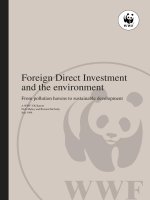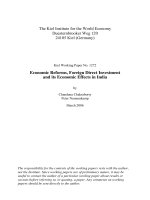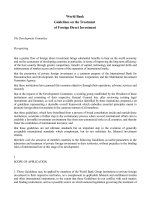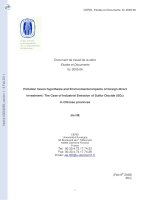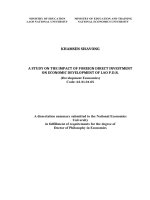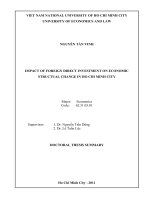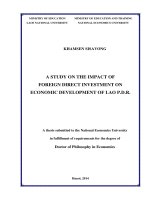The impact of foreign direct investment and economic growth on CO2 emission empirical study in ASIA
Bạn đang xem bản rút gọn của tài liệu. Xem và tải ngay bản đầy đủ của tài liệu tại đây (1.08 MB, 69 trang )
UNIVERSITY OF ECONOMICS
INSTITUTE OF SOCIAL STUDIES
HO CHI MINH CITY
THE HAGUE
VIETNAM
THE NETHERLANDS
VIETNAM - NETHERLANDS
PROGRAMME FOR M.A IN DEVELOPMENT ECONOMICS
The impact of foreign direct investment and
economic growth on CO2 emissions:
Empirical study in ASIA
A thesis submitted in partial fulfilment of the requirements for the degree of
MASTER OF ARTS IN DEVELOPMENT ECONOMICS
By
DO DANG NGOC GIAU
Academic Supervisor:
Dr. PHAM KHANH NAM
HO CHI MINH CITY, NOVEMBER 2015
1
DECLARATION
―I certify that the substance of this thesis has not already been submitted for any
degree and have not been currently submitted for any other degree.
I certify that to the best of my knowledge and help received in preparing this thesis
and all sources used have been acknowledged in this thesis.‖
HCMC, November 2015
Signature
DO DANG NGOC GIAU
2
ACKNOWLEDGEMENTS
This process of writing a thesis is a collaborative experience involving the support
and helps from many people. I want to express my gratitude to those who give me the
tremendous support to complete this thesis.
I greatly express my special thanks to my supervisor Dr. Pham Khanh Nam for all
his academic recommendations through finishing this process.
I would like to express my deepest gratitude to Dr. Truong Dang Thuy for his
suggestion which help me handle some problems in this thesis.
I wish to express my heartfelt gratitude to Dr. Vo Hong Duc who gives me some
logical ways in order to present confidently in this thesis.
During my time at VNP, I receive a great encouragement and help from some
friends, so I am grateful to Mr.Vo Van Hung, Mr.Trinh Hoang Viet and Ms. Vo Tan
Thanh Diep, for motivating me to overcome all difficulties in the process of thesis.
Especially, I greatly thanks to Mr. Pham Ngoc Thach and Mr. Nguyen Son Kien for their
help and sharing of their econometric knowledge.
3
ABSTRACT
This paper is to investigate the effects of foreign direct investment (FDI) inflows
and economic growth on CO2 emissions in Asian countries over period from 1991 to
2013. Under the complexity between these variables, this paper applied panel analysis
method and structural equation model (SEM) to explore the influence of FDI, economic
growth on CO2 emissions. The result indicates that FDI inflows contribute to reduce CO2
emission (improve environmental quality) while economic growth make CO2 emissions
level increase. Moreover, the result shows the two-way linkages occur between CO2
emissions and FDI inflows, CO2 emissions and economic growth. In addition, the
unidirectional nexus exists from economic growth to FDI inflows.
Keywords: Foreign direct investment; economic growth; CO2 emissions; SEM;
Asian countries.
4
ABBREVIATIONS
GDP:
Gross Domestic Product
FDI:
Foreign Direct Investment
CO2:
Carbon Dioxide
SEM:
Structural Equation Modeling
FEM:
Fixed Effects Model
REM:
Random Effects Model
OLS:
Ordinary Least Squares
PHH:
Pollution Haven Hypothesis
EKC:
Environment Kuznets Curve
5
TABLE OF CONTENTS
CHAPTER 1 INTRODUCTION...................................................................................... 8
1.1. Problem statement .................................................................................................. 8
1.2. Research Objectives ............................................................................................. 10
1.3. Research Questions .............................................................................................. 10
1.4. Research Scope and Methodology ....................................................................... 10
1.5. Thesis Structure .................................................................................................... 11
CHAPTER 2 LITERATURE REVIEW ....................................................................... 12
2.1. Pollution Haven Hypothesis. ................................................................................ 12
2.2. Pollution Halos Hypothesis. ................................................................................. 14
2.3. Environmental Kuznets Curve Hypothesis (Theory of economic growth –
environmental quality) ......................................................................................... 15
2.4. Empirical studies related to Pollution Haven Hypothesis .................................... 16
2.5. Empirical studies related to Pollution Halos Hypothesis ..................................... 18
2.6. Empirical studies on the impact of FDI, economic growth on CO2 emissions .... 19
2.7. Empirical studies on the three-way linkages between FDI-economic growth-CO2
emissions.............................................................................................................. 22
CHAPTER 3 RESEARCH METHODOLOGY ........................................................... 25
3.1. Analytical framework ........................................................................................... 25
3.2. Model specification .............................................................................................. 27
3.3. Data and Defining Variables ................................................................................ 32
3.3.1.
Data ............................................................................................................... 32
3.3.2.
Defining Variables ........................................................................................ 34
6
3.4. Econometric methodology ................................................................................... 37
3.4.1.
Panel analysis ................................................................................................ 37
3.4.2.
Structural equation modeling ........................................................................ 43
CHAPTER 4 EMPIRICAL RESULT ........................................................................... 46
4.1. Overview about CO2 emissions, economic growth and FDI in Asia ................... 46
4.2. Descriptive statistics ............................................................................................. 48
4.3. Regression diagnostic ........................................................................................... 49
4.4. Regression results ................................................................................................. 51
4.4.1.
Regression result from panel method ............................................................ 51
4.4.2.
Regression result from structural equation model ........................................ 53
CHAPTER 5 CONCLUSIONS AND POLICY IMPLICATIONS ............................. 59
5.1. Conclusion ............................................................................................................ 59
5.2. Policy implications ............................................................................................... 60
7
CHAPTER 1
INTRODUCTION
1.1.
Problem statement
In recent years, climate change and environmental degradation are the major
concerns toward many countries all over the world, especially in ASIA. These problems
cause many difficulties in poverty reduction and economic development (World Bank,
2015). Moreover, human health is threatened as well as cost for health-care sector is
increased by environmental degradation. Neria (2014) suggested that approximately 3
million people worldwide die every year by environmental pollution. Many researchers
found that one of major factors, which causes the climate change and environmental
degradation is carbon dioxide (CO2 emissions) (Pittock, 2003; Solomon et al., 2007).
They has pointed out that the surge of CO2 emissions level pushes greenhouse gases in
atmosphere and leads to climate change threats to socio-economic systems.
As a matter of fact, environmental degradation is caused by human activities such
as industrialization, burning of fossils fuel and deforestation. Human activities are
operated to develop economy and improve life quality. Under enormous pressure of
sustainable economic development goal, many countries increase extraction, production
and especially industrialization. Consequently, these activities cause high pollution level.
It goes to show that economic growth is one of the main reasons of environmental
degradation (Dell et al. 2008). The effects of economic growth on environmental quality
(CO2 emissions) are analyzed by many previous studies. The link of emissions and
economic growth is closely related to the context of Environment Kuznets Curve
(EKC) hypothesis. The EKC theory suggests that the emission level increases with a
rising in per capita growth of GDP, and it declines after reaching at ―turning point‖
(sustainable income level). From above discussions, this thesis will emphasize on
analyzing the impact of economic growth on CO2 emissions.
Furthermore, the impacts of Foreign Direct Investments (FDI) on environmental
quality are discussed by many researches. The study of Smarzynska (2001) suggested
8
that FDI would be considered as main determinant of environmental quality. Even though
FDI contributes to promote economic growth, it reduces the environmental quality.
According to Pollution Haven Hypothesis, FDI leads to the decline in environmental
quality since most of polluting industries from developed countries tend to move to
developing countries in order to avoid abatement cost from stringent environmental
legislation. Thus, pollution may increase together with the rising in FDI at recipient
countries. On the contrary, Pollution Halos Hypothesis claims that FDI may improve
environmental quality in host countries via transferring superior technology and ―green‖
input products. Moreover, recipient countries obtain more chances to learn the skills of
environmental management system from foreign countries. In both points of view, there
are two possible impacts of FDI on environmental quality. This thesis will examine the
impact of FDI on CO2 emission base on two theories.
In 2014, Asia was one of regions which received the highest amount of FDI in
comparison with the rest of the world, accounting for 30 percent global FDI inflows
(UNCTAD, World Investment Report 2014). More importantly, FDI is considered as
vital resource of economic growth toward Asian countries. The increasing of FDI into
Asia leads to promote economic growth in many Asian countries. In addition,
environmental degradation is one of the main concerns in many ASIAN countries.
According to the statistic of World Health Organization in 2013, Asia has the highest
number of polluted cities. As such, this pollution causes many damages to human health.
Therefore, pollution becomes enormous pressure toward Asian countries. Until now,
there are many studies of the relationship between environmental quality, economic
growth and FDI. The empirical results of these studies are ambiguous. Therefore, this
thesis attempts to answer the question whether FDI and economic growth have influence
on CO2 emissions for Asian countries.
The finding from this thesis will provide evidence support the current literature
related to the impact of FDI, economic growth on CO2 emissions. Moreover, this study
9
gives several suggestions for policy maker in order to achieve the goal of reducing CO2
emissions as well as improving environmental quality in Asian countries.
1.2.
Research Objectives
This thesis is to understand the impact of foreign direct investments (FDI) on
environmental quality in the context of Asian countries, based on argument of Pollution
Haven Hypothesis and Pollution Halos Hypothesis.
In addition, this thesis attempts to investigate the relationship between economic
growth and environment quality. The results would provide research evidences on the
general relationship between FDI, economic growth and environmental quality. This
knowledge would be a contribution to the literature on the linkages between the economy
and environment.
1.3.
Research Questions
In order to achieve the research objectives, this thesis attempt to the answer these
following questions:
Does foreign direct investment lead to increase CO2 emissions in ASIA?
Does economic growth cause an increase in CO2 emission in ASIA?
1.4.
Research Scope and Methodology
This thesis investigates the influence of FDI, economic growth and other
determinants (trade openness, level of democracy and scale of economic activity) on CO2
emissions by using Asian countries sample. The data is collected from 1991 to 2013 due
to its availability.
Since the possibility of endogeneity between CO2 emissions, economic growth and
FDI (based on suggestion from previous studies that will present in empirical studies),
this thesis applies Structural Equation Model (SEM) to estimate the simultaneous
equation model which presents the effects of economic growth and FDI on CO2
emissions.
10
1.5.
Thesis Structure
This thesis consists of five main chapters.
Chapter 1: Introducing the research.
Chapter 2: Reviewing theoretical framework and previous empirical studies that
related to the effects of economic growth, FDI on CO2 emission
Chapter 3: Presenting the conceptual framework, the way to build model and
econometric technique for estimating result of analysis.
Chapter 4: Showing the estimation result that interprets the relationship between
variables.
Chapter 5: Summarizing the main finding and bringing out some limitation as
well as suggestion for future studies.
11
CHAPTER 2
LITERATURE REVIEW
This chapter presents both the theoretical and empirical aspects of the relationship
between FDI and CO2 emissions. There are two sections in this chapter. The first section
is to discuss about two of theory: Pollution Haven Hypothesis and Pollution Halos
Hypothesis. The second section is about the empirical studies including previous studies
that have investigate the relationship between FDI and CO2 emissions based on Pollution
Haven Hypothesis and Pollution Halos Hypothesis. Moreover, this chapter will discuss
about the empirical studies related to causal relationship between FDI-CO2 emissions and
economic growth.
2.1.
Pollution Haven Hypothesis.
From the theoretical view, Pollution Haven Hypothesis (PHH) prefers that FDI has
a negative effect on environmental quality. PHH argues based on Heckscher-Ohlin
theorem (Heckscher, (1919) and Ohlin (1933). According to, comparative advantage of
Heckscher-Ohlin theorem, Pollution Haven Hypothesis has considered ―lax‖ of
environmental regulation as a comparative advantage in polluting industries. In addition,
Dasgupta et al. (1999) supposes that the countries with low environmental standards
might be a ―pollution haven‖ for polluting industries. As stated by Hechscher-Ohlin
theorem, a region with an abundant factor such as labor or capital would have a
comparative advantage in producing goods that use abundant locally factor. Therefore,
this region should specialize in producing and exporting these comparable goods.
Accordingly, in developed countries, especially countries have a large of polluting
industries, tightening up environmental policy is synonymous with the high abatement
cost. An increase in production cost together with a high penalty fee will lead to the
relocation in ―dirty‖ industries. In other words, cost of the inputs for pollution-intensive
production is increased by stringent environmental law such as fee, taxes or permitting
costs toward polluting goods. In order to avoid cost of the stringent environmental
regulation, the relocation of polluting industries will be expanded to countries where
12
national environmental standards are lower. With the low environmental regulation, a
nation therefore has a comparative advantage in attracting polluting industries. As already
discussed above, the pollution is likely to increase as a result of relocation of polluting
industries and potential threat from foreign investment. It goes to show that Pollution
Haven Hypothesis state that ―dirty‖ industries tent to move to countries with weaken
environmental regulation and cause environmental damage.
Aliyu (2005) suggests that there are three dimensions of Pollution Haven
Hypothesis. First, Global free trade make polluting industries relocate to ―lax‖
environmental policies to avoid abatement cost. Second, the developed nations or
industrial and nuclear energy production have a propensity to dump hazardous waste to
developing countries. Finally, overexploiting non-renewable resources of multinational
cooperation in poor countries to produce petroleum products causes many environmental
problems such as climate change or arises in CO2 level.
To support the PHH theory in general and to investigate the relationship between
economic activities and stringent environmental legislation, previous studies have
focused on following econometrics equation:
(1)
In which Y is economic activity, R is regulatory stringency, X are other
determinants that may affect Y.
To advocate the PHH theory, the sign of α is expected to be negative, which means
the level of environmental regulation has negative effects on economic activities. In the
left hand side of equation, the previous studies have used international trade, foreign
direct investment, net export and so forth as proxies for economic activities.
However, measuring the level of environmental regulation is difficult. The problem
is answer the question how much the cost from regulation is. In order to
measure level of stringent environmental regulation, environmental taxes or fees,
permitting cost… had been utilized in the earlier research. In addition, some studies have
13
also used emission level to present for stringent environmental regulation with argument
that large of number emissions is signal of weaken environment regulation. However,
using cross-section data gets some troubles in estimation. Namely, cross-section date is
considered that it may not control the unobservable heterogeneity and endogeneity
problem. Then estimation result could be biased. Hence, the subsequent studies applied
panel data to handle unobservable problem. In some cases, the stringent and pollution are
determined simultaneously. Then, instrument variable becomes a better way to solve
endogeneity problem. The findings of subsequent studies are better than previous ones
and provide a higher statistical significance for estimators. To sum of, it could be
deduced that FDI has negative effects on environment through the relocation of polluting
industries and movement of capital.
2.2.
Pollution Halos Hypothesis.
In contrast with PHH theory, Pollution Halos Hypothesis (Halos Effects
Hypothesis) suggests that industrial location and capital flow from foreign countries play
an important role in improving environmental quality in host countries by transferring
superior technologies, cleaner production methods and diffusing better environmental
management skills. The Halos theory not only focuses on FDI firm’s decision from
effects of environmental regulation but also concerns about the environmental
performance in recipient countries (Zarsky, 1999). First, in general, multinational firms
may bring the cleaner energies, newer techniques from foreign countries to domestic
countries that may enhance production productivity. It is not surprising as a wealthy and
developed economy has enough capital ability for investment outside its border. As a
result, the domestic firms have more opportunities to learn ―green‖ techniques that result
in reducing pollution level. Furthermore, improving environmental quality is also
depended on environmental knowledge as well as environmentally conscious behavior
that are diffused from trained workers from foreign countries. Second, it is thought that
multinational firms themself are usually stringent in environmental legislation and have a
better environmental management due to characteristics of developed economy. Zarsky
14
(1999) offered evidence for this statement with the sample of OECD countries.
Specifically, OECD is regarded as a powerful economy and a potential resource for other
countries, especially poor countries. The main activities of these countries focus on
discussing and issuing policies related to economic development, trade, improving
technology and environment. Therefore, OECD firms have a stringent environmental
management system. However, sometimes, foreign countries pay attention to the
environmental standard in host countries or require an equal standard in some cases.
According Zarsky (1999), ―there will be no ―Halos‖ effects if the foreign company itself
is an environmental polluter‖.
2.3.
Environmental Kuznets Curve Hypothesis (Theory of economic growth –
environmental quality)
As regards the relationship between economic growth and environmental quality,
many researchers (Elbert et al., 2001; Cole, 2004) hold the view that it is close to the
context of Environment Kuznets Curve (EKC) theory. In the economic, Kuznets Curve
hypothesis indicate the relationship between economic growth and inequality (Kuznets,
1955). Then, in 1991, this hypothesis is developed into Environmental Kuznets Curve
theory which is a standard feature to describe the effects of economic growth on
environmental quality (Stern et al., 1996). The EKC theory posits that in the first stage of
development economic environmental quality reduce, and after reaching at sustainable
development, environmental pollution will be improve. In other words, in low income
level protection of the environment is not first priority since every person tends to make
use of their income to satisfy their individual basic needs. In the broad scale, early stage
of economic growth, entire society focuses on promoting production with all of available
resources. Therefore, environmental damage increase sharply, and furthermore pollution
is created from industrialization. However, subsequent to reach certain level of income,
demand of environmental quality is paid attention. Thence, entire society as well as
government concentrates on improving environmental quality together with economic
growth. Nonetheless, most of examination of the EKC in many studies related to air
15
pollution concern (Shafik, 1994; Liu, 2007). As a result, EKC has become the theoretical
base for government in order to control volume of air pollution (such as CO, CO2, SO2
emissions) by increasing economic growth.
2.4.
Empirical studies related to Pollution Haven Hypothesis
Theory of Pollution Haven Hypothesis has been tested by many empirical
researches. Most of empirical studies investigate the effects of level of stringent
environmental regulation on the competitiveness (net export, net inflow of foreign
investment, new plant birth and so forth) (Copeland, 2013).
Keller and Levinson (2002) carried out the research on 958 new foreign-owned
factories in United State over period from 1977 to 1994. In order to measure level of
stringent environmental regulation, the industries-adjusted index of environmental
abatement cost is used. The higher the industries-adjusted index in a region is more
stringent environmental regulation. Moreover, the unobserved heterogeneity that is
potential correlated between FDI and level of environment regulation is controlled by
Fixed Effects estimation. However, by using GMM approach, the result implies that high
stringent level causes a decrease in FDI, especially in pollution industries.
In another study, Aliyu (2005) also tested the PHH in two groups of countries from
1990-2000. They are eleven OECD countries and fourteen non-OECD countries. In this
study, it is assumed that stringent environmental legislation increases FDI of polluting
industries out of country and amount of pollution tends to go up in recipient
countries.More important, based on testing whether PHH exists or not, this research uses
environmental tax as proxy for stringent,so as to check the influence of environmental tax
on movement of industries. Accordingly, the result of this research provides the statistical
significance in the positive relationship between environment tax and outcoming of
polluting industriesin developed countries. Unfortunately, the effects of FDI inflow in
developing countries on pollution (CO2 emissions) is not consistent.
16
In an analysis of firm level data on US-based multinational companies from 1966 to
1999, Hanna (2010) provided evidences supporting for PHH through investigating the
effects of environmental legislation on FDI flows. Clean Air Act Amendments (CAAA)
is one of the first organizations in United States, which may influent on environmental
policy and controls the level of national air pollution all over the world. Under CAAA’s
control, the result indicates that level of regulation faced by multinational firm is
increased, and so movement of FDI based on multinational firm out of United States
grows. Besides, stringent environmental regulation may drop the productivity of foreign
firms because the enormous pressure from environmental regulation induces them not to
operate with full capacity.
Hassaballa (2013) conducted the test between PHH and Pollution halos hypothesis
by estimating the effects of FDI inflow on emissions in developing countries. This
research finds that FDI inflows have positive effects on environmental quality and
consistent with Pollution haven hypothesis in some countries such as Algeria, Cameroon,
Iran, and Mexico. Moreover, this research also gives evidence about the causality
between FDI inflow and pollution emissions by applying Granger causality test.
Furthermore, some previous studies test PHH theory. However, their results are
ambiguous. Eskeland and Harrison (2003) carried a study to test PHH in three countries
(Co^te d’Ivoire, Venezuela, Morocco). The result implied that regions with high level of
pollution get more foreign investment. Since cleaner energy is used in foreign factories
that operate in high level of pollution region, it is not matter in industrial relocation. In
another work, Elliot and Shimamoto (2008) measured stringent environmental regulation
by firm’s total amount of investment cost for pollution abatement in each of the
manufacturing industries surveyed by the Japanese Ministry of Economy. Assumption of
this research is that high pollution abatement costs in Japan makes company move out of
nation. The study is conducted in three countries: Indonesia, Philippine, Malaysia. These
countries are FDI recipient from Japan. The empirical result indicates that influence of
high environmental regulation on industries relocation is significant. Nonetheless, the
17
coefficient has negative sign in Philippine. This means that outbound FDI from Japan is
not affected by stringent environmental regulation in Japan.
2.5.
Empirical studies related to Pollution Halos Hypothesis
Recently, some studies provide evidences supporting The Halos theory. Most
studies examine the spillovers effects from FDI to environment. In addition, while there
are many researches show the negative relations between FDI and environment, some
provide the mixed results.
Several studies have found positive effects of FDI on environmental quality. Cole et
al. (2008) examined whether foreign ownership made domestic firms increase the access
to cleaner technology and reduced fuel energy consumption. This research investigated
the sample of 84 firms of six sectors in Ghana in the period 1991-1997. He found that
foreign firms have an influence on environmental performance in domestic firms.
Specifically, the local firms have more chances to practice new technology, make use of
environmental-friendly input products from foreign countries. More importantly, the
local firms operate with efficiency energy since learning from high skill of environmental
management. Nevertheless, the decision to apply this technology may be depended on the
experience of the firm’s head. Blackman and Wu (1998) provided the same conclusion
about the positive effects of FDI. In this work, these authors analyze the effects of FDI on
energy consumption in Chinese power sectors by conducting a survey in 20 FDI plant.
According to the survey result, the volume of FDI into power sector in China increases
and lead to most of FDI plants improved in their productivity and scale since FDI
transfers high technology and new equipment.
Doytch and Uctum (2011) suggested that capital inflows bring benefit to developed
countries, which supports for Halos Hypothesis. Furthermore, they also investigate on
firm-level and find that FDI which put into services sector do not lead to an increase in
CO2 emissions. However, another result from this study is opposite to Halos Hypothesis
when measure pollution by CO emissions and consistent with Pollution Haven
Hypothesis. Another contribution of this study in comparison with the previous studies is
18
the application of the Generalized method of moments (GMM) to estimate dynamic panel
data. Besides testing the Pollution Halos Hypothesis, Doytch and Uctum (2011) also set
up an examination for Pollution Haven Hypothesis and Environment Kuznet Curve.
Some studies also analyze Halos Effects Hypothesis; nonetheless, the result is still
mixed. For instance, Dasgupta et al. (2000) investigated the effects of regulation, plantlevel management policies and other determinants on environmental compliance of firms.
This study uses the data of manufacturers in Mexico in 1995 and applies the two-stage
least square technique to analyze probit equation. Unfortunately, the estimated result
implies that environmental performance of firms is not affected by foreign ownership of
firms which are OECD firms. Moreover, the result indicates that the plants with new
equipment, high technology do not seem to provide a better environmental management
for local firms. This result of study is not in line with Halos Hypothesis.
2.6.
Empirical studies on the impact of FDI, economic growth on CO2 emissions
Reviewing the theories on the relationship between foreign direct investments,
economic growth and environmental quality is very necessary and helpful. Nonetheless,
it is not less of learning from previous empirical evidences since these studies not only
provide the results about the effects of FDI and economic growth on environment but
also investigate other possible determinants which may have effects on environment.
Laing (2006) set up examination to find an answer for the question ―Does foreign
direct investments (FDI) harm to host countries?‖ with the sample of 260 cities in China
between 1996 and 2003. The author expects that FDI may bring benefit and do not
damage environmental quality. Furthermore, this study investigates the relationship
between trade openness, income and environmental quality (measured by SO2 emissions).
In addition, a major concern in this study is the possibility of endogeneity problem due to
omitting variable. Laing then uses two variables ―geography location‖, ―trade policy‖ as
the instruments for foreign direct investments to handle the endogeneity concern. The
analysis is estimated using Fixed Effects method for both with and without instrument
variables scenario. The result presents that the correlation between FDI and SO2
19
emissions is negative, suggests that SO2 emissions in a city of China could be reduced
with the increase of FDI. FDI has been proven to improve environment via transferring of
new technology and ―green‖ goods.
Several studies have looked at FDI inward and outward in explaining changes in
environmental quality. Bernauer and Koubi (2009) provided empirical studies about the
effects of globalization and democracy on environmental quality in 153 countries over
period from 1990 to 2004 by using regression analysis for panel data. In this study,
channels of Globalization are regarded in three aspects: trade openness, capital flows and
international policy cooperation which contribute to increase economic development.
Accordingly, together with globalization, particularly economic development, pollution
tends to increase based on the context of Environmental Kuznets Curve (EKC). In this
study, these authors (Bernauer and Koubi, 2009) have measured economic growth by the
real GDP and find the result consistent with EKC theorem. Moreover, FDI is a proxy for
capital flow and is discriminated between FDI inward and FDI outward since they
believe that FDI may bring benefit and cost for nation. The finding of this study indicates
that FDI inward causes enormous pressure on environmental quality. Conversely, FDI
outward improves environment. Besides, Factor Endowments Theory is also considered
in this study to examine the influence of trade openness on environmental quality. Last
but not least, these authors examine the impact of democracy on environment. By using
the ranking of democracy level from Polity IV database and degree of participation in
international environmental treaties, the study result implies that high level of democracy
does not reduce environmental quality while participation in international environmental
treaties do not present the effects on environment.
Sharma (2011) conducted a study about the determinants (consist of trade
liberalization, income, urbanization, and energy consumption) of environment (CO2
emissions) for global panel including 69 countries during 1985-2005. The sample is
divided into three groups of income level: high, middle and low income. This study
applies GMM method (suggested by Arellano and Bond (1991)) to estimate the dynamic
20
model because of the effects of lagged level of CO2 emissions. This study indicates
different results among three groups of income level countries. To be more specific, the
result implies that while income has positively significant effects on CO2 emissions in
middle and low-income regions, it has no effects in high-income region. Besides,
urbanization is one of main determinant that affects CO2 emission in high-income
countries.
Grossman and Krueger (1991), Selden and Song (1994), Rothman (1998) estimated
the relationship between economic growth and environmental quality and provide
evidences supporting for EKC. This means pollution tends to increase in the first stage of
economic degradation but beyond the sustainable point of average income, pollution will
be decline. Following the empirical findings from previous studies, Asghari (2013) uses
the reduced form of econometric model and panel data of six countries in Middle East
and North Africa (MENA) from 1980 to 2011 to estimate the effects of FDI on
environmental quality by applying the Fixed Effects Model. For the dependent variable in
analyzed model, author chooses CO2 emission of industrial pollutants as proxy. To get
some sense of the factors which affect environment, other control variables are
considered that the real Gross domestic product (GDP), share of industry in GDP, trade,
population density and corruption perception index. This paper implies that FDI inflow
transfers cleaner technology to make environment become better. This result again
provides evidence support Halos Hypothesis. In addition, this paper provides evidences
consistent with the conclusion of Blackman and Wu (1998), Cole (2008).
In a related study, Halicioglu (2008) found positive effects of income, foreign trade
and energy use on environmental quality in Turkey. In the same way, Farhani (2013)
carried out the research about the impact of economic growth and other determinants on
CO2 emissions. This research uses panel data in eleven countries of Middle East and
North Africa (MENA) over period 1980-2009. He (Farhani, 2013) estimated regression
in two groups by using Fully Modified Ordinary Least Square (FMOLS) and Dynamic
Ordinary Least Square (DOLS) methods. First, he investigates environmental effects of a
21
group of indicators including income, energy consumption, and trade liberalization. The
result of FMOLS and DOLS indicate that the increases in energy use and trade lead to
CO2 emissions go up. In addition, the effect of income on CO2 emissions is in line with
EKC. Second, with address of urbanization variable (using urban population in total) into
model, he finds the similar result with the positive and significant effects on CO2
emission, apart from negative effects of urbanization determinant. The estimated result
reveals that the conduction of urbanization reduces the CO2 emissions in the respect of
energy use. This means that the coefficient of energy consumption variable becomes
lower than in equation without urbanization.
2.7.
Empirical studies on the three-way linkages between FDI-economic growthCO2 emissions
The influence of foreign direct investments and economic growth on environmental
quality is analyzed by many previous studies. However, in recent studies, many
researchers propose that among FDI, economic growth and environment is the possibility
of bidirectional relationship. This mean that the relationship between three couple of CO2
emissions–economic growth, CO2 emissions FDI and economic growth – FDI working in
both directions, including unidirectional effects and feedback effects. Making an
examination of bidirectional relationship between these determinants is very necessary.
First, this thesis will consider the interaction between FDI and economic growth
(GDP growth as a proxy). Applying annual data of macro determinants from 1960 to
2005, Ang (2008) provided evidence that the GDP and GDP growth have positive effects
and play an important role in attracting FDI flows in Malaysia. This means that the
growth of economy results in more FDI inward. Besides, the author also implies that
trade openness and infrastructures are contributing to promote FDI inflows. The result of
this study has been confirmed by Chakrabarti (2001), Fedderke and Romm (2006). In the
similar way, Anwar and Sun (2011) constructed a simultaneous equation that present the
interaction between ―foreign investments‖, ―domestic capital‖ and ―economic growth‖.
This research is analyzed for Malaysia over period from 1970 to 2007 by using time
22
series data. Based on suggestion of Arellano and Bond (1991), authors used GMM
technique to estimate the simultaneous equation. As such, they find the unexpected result
that there is insignificance unidirectional effect from economic growth to foreign
investments. However, the foreign investments have positive and statistically significant
effects on economic growth. In order to find strong evidence for the two-way links
between FDI and economic growth, Anwar and Nguyen (2010) made an investigation for
61 cities in seven regions in Vietnam from 1996 to 2005. By using the simultaneous
equation model and GMM estimation, this paper reports the result that the two-way links
between economic growth and FDI inflow exist in four regions (i.e. Red River Delta,
North East, South East and Mekong River Delta). Specifically, the FDI inflows increase
with economic growth and economic growth is also increase with arise of FDI inflows.
This result is consistent with Tsai (1994).
Second, there are many studies confirm causal links of pollution and economic
growth. Halicioglu (2009) analyzed the relationship among economic growth, energy use,
trade openness and CO2 emission by using time series data in Turkey from 1960 to 2005.
Soytas and Sari (2009) set up an investigation for economic growth, energy use and CO2
emissions in Turkey during 1960-2000. In addition, Ghosh (2010) examined the
economic growth and CO2 emission relation in India over period 1971-2006. Applying
Ganger Causality Test, these studies report a same conclusion that between economic
growth and CO2 emissions (proxy for pollution) have two-way effects. However, some
studies find the mixed results for economic growth and pollution nexus. Take examples,
study in Malaysia of Ang (2008) and study in South Africa of Menyad and Rufael (1995)
confirmed the evidence about the relationship between the CO2 emissions and economic
growth, indicating that arise of CO2 emissions causes economic growth declines and
without feedback effects from economic growth on CO2 emissions.
Third, it is believed that between FDI and pollution are causal nexus. Hoffmann et
al. (2005) used the Granger causality test to test the relationship between FDI inflow and
CO2 emissions (as a proxy for pollution) by using sample of 112 countries in over the
23
world. This paper divides sample into three groups of countries (low, middle and high
income) and they report the unidirectional causality from CO2 emission to FDI inflow in
low income countries but middle income countries is opposite. Another study, Zhang
(2011) provided the result that factor of finical development including FDI can lead to the
changing in CO2 emission in China.
Finally, the nexus among economic growth (or income), FDI and CO2 emission has
been discussed in recent studies. In addition, study of Omri et al. (2014) is to understand
the bidirectional between CO2 emissions, economic growth and FDI. Their study is
analyze for panel including 54 countries in 1990-2011 and applies GMM technique to
estimate simultaneous equation which present the causal nexus between these variable.
The result implied that there are two-way linkages between CO2 emissions –FDI,
economic growth – FDI and the unidirectional nexus from CO2 emissions to economic
growth without feedback effects. Similarly, Tang and Tan (2015) attempt to investigate
relationship between CO2 emissions, economic growth and FDI for Vietnam from 1976 to
2009. By applies cointergration and Granger causality test, this research reveal the result
that FDI and income play important role in effects on CO2 emissions. Moreover, this
study provides evidence support three-way linkages causal relationship among income,
CO2 emissions and FDI.
In sum of the previous studies which are already reviewed, it is obvious that there is
the causality between CO2 emissions- FDI- economic growth (income).
24
CHAPTER 3
RESEARCH METHODOLOGY
3.1.
Analytical framework
On the theory and empirical analysis, this paper show the complex relation of CO2
emissions, economic growth and foreign direct investment through the analytical
framework. Accordingly, the effects of some exogenous variables is also presented in this
graph.
Firgue 1:
Conceptual Framework
FDI
Capital Stock
CO2 Emissions
Economic
Growth
Trade openness
Polity
Activity
Source: Author’s analysis
25

